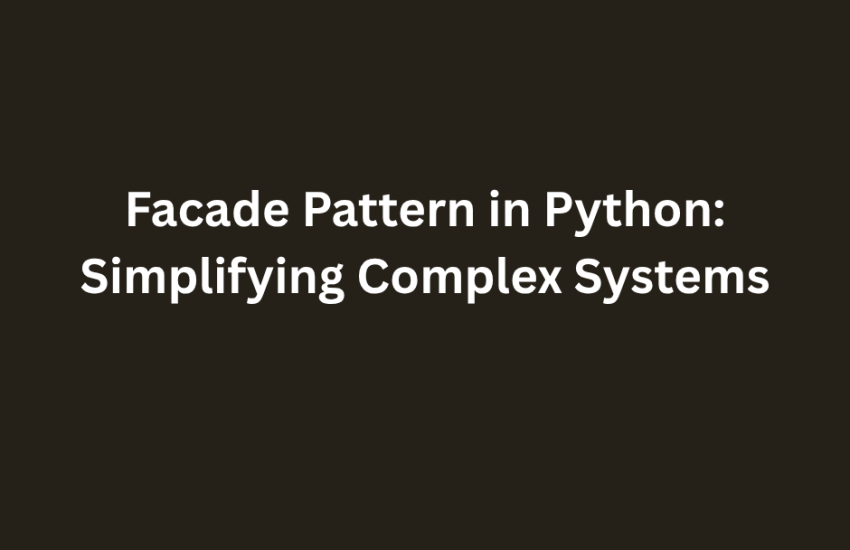Understanding the Problem
Consider a scenario where a developer must integrate multiple subsystems, such as authentication, database operations, and logging. Directly interacting with these subsystems can lead to the following issues:
- Increased Complexity: Clients must understand the intricate details of each subsystem.
- High Coupling: Changes in one subsystem may require changes in the client code.
- Code Redundancy: Multiple clients may implement similar logic to use the subsystems.
The Solution: Facade Pattern
In software design, the Facade Pattern is a structural design pattern that provides a simplified interface to a complex subsystem or a set of related classes. The pattern encapsulates intricate processes, making it easier for clients to interact with the system without needing to understand its complexity. This approach enhances usability and reduces coupling between the client and the subsystem.
The Facade Pattern addresses these issues by:
- Providing a unified interface to a set of interfaces in the subsystem.
- Delegating client requests to the appropriate subsystems without exposing the complexities.
In Python, the pattern is implemented by creating a class that acts as the “facade,” encapsulating the subsystems.
Key Characteristics of the Facade Pattern
- Simplified Access: The primary purpose of the facade is to abstract away complexity. Clients only interact with the facade instead of individual subsystems.
- Encapsulation: The facade shields the internal subsystems from direct access, ensuring the system’s modularity and maintainability.
- Separation of Concerns: By delegating client requests to subsystems, the facade ensures that the business logic remains organized and the client code stays clean.
Where the Facade Pattern is Useful
- Complex Systems: When dealing with complex libraries, APIs, or frameworks, a facade can simplify their usage by providing a higher-level API.
- Legacy Code Integration: When integrating with older systems, a facade can help bridge the gap between the old code and modern interfaces.
- Enterprise Applications: Large-scale enterprise systems often consist of multiple subsystems, such as authentication, logging, payment processing, etc. The facade can provide a single entry point for these functionalities.
Why is the Facade Pattern Important?
1. Reduces Complexity for the Client
- Consider a large e-commerce platform. Without a facade, a developer implementing an order checkout flow might need to:
- Interact with the inventory system.
- Verify payment through the payment gateway.
- Update order status in the database.
- Send notifications via email or SMS.
- Each of these tasks requires understanding the specific APIs of the subsystems. A facade can abstract these steps into a single checkout() function, drastically simplifying the developer’s task.
2. Promotes Decoupling
Decoupling is a core principle in software design. By isolating the client from subsystem details, the facade acts as a middle layer. Changes to subsystem logic can often be accommodated without modifying the client code.
3. Improves Maintainability
As applications grow, maintaining direct relationships between clients and subsystems becomes cumbersome. Introducing a facade consolidates interaction points, making it easier to manage and update the codebase.
How the Facade Pattern Works?
The facade pattern typically involves:
- Subsystems: These are the components or classes that perform specific tasks. Subsystems operate independently but may require coordination.
- Facade Class: The facade is a high-level interface that interacts with the subsystems on behalf of the client. It coordinates subsystem calls and provides a cohesive interface.
- Client: The client uses the facade class to perform operations. The client doesn’t interact with subsystems directly.
Advantages of the Facade Pattern
- Improved Usability: The facade simplifies the system for external users, making it more approachable.
- Enhanced Code Readability: With the facade encapsulating logic, the client code remains focused on its primary tasks.
- Better Testing and Debugging: By isolating subsystem interactions, the facade makes it easier to test and debug.
- Scalability: Adding new functionalities to the subsystem often doesn’t require changes to the client, as the facade can adapt to subsystem changes.
- Consistency: The facade ensures a uniform interface, reducing the chance of misuse by different clients.
In this example, we’ll implement a Travel Booking System that handles flight booking, hotel reservations, and cab bookings. Each subsystem will have its own class, and the facade will provide a unified interface to simplify the booking process.
Subsystem Classes
Each subsystem represents a specific functionality, such as booking flights, reserving hotels, or arranging cabs.
class FlightBooking:
def book_flight(self, destination):
print(f"Flight to {destination} booked successfully!")
return True
class HotelBooking:
def book_hotel(self, destination, nights):
print(f"Hotel in {destination} booked for {nights} night(s)!")
return True
class CabBooking:
def book_cab(self, destination):
print(f"Cab booked to travel around {destination}!")
return True Facade Class
The facade encapsulates the complexity of dealing with multiple subsystems. It provides a simplified interface for clients.
class TravelFacade:
def __init__(self):
self.flight = FlightBooking()
self.hotel = HotelBooking()
self.cab = CabBooking()
def book_entire_trip(self, destination, nights):
print(f"Booking a trip to {destination} for {nights} night(s)...")
if self.flight.book_flight(destination) and \
self.hotel.book_hotel(destination, nights) and \
self.cab.book_cab(destination):
print("Entire trip booked successfully!")
else:
print("Failed to book the trip.") Client Code
The client interacts only with the facade and doesn’t need to deal with the details of each subsystem.
if __name__ == "__main__":
# Client wants to book a trip to Paris for 3 nights
travel_facade = TravelFacade()
travel_facade.book_entire_trip("Paris", 3) Output
When you run the above code, you get:
Booking a trip to Paris for 3 night(s)...
Flight to Paris booked successfully!
Hotel in Paris booked for 3 night(s)!
Cab booked to travel around Paris!
Entire trip booked successfully!Conclusion
The Facade Pattern is an essential tool for Python developers looking to manage complexity and enhance the usability of their systems. By introducing a simplified interface, the pattern not only improves the developer experience but also promotes maintainability and scalability. While it’s not suitable for all scenarios, its strategic use can significantly streamline the interaction between clients and subsystems.




